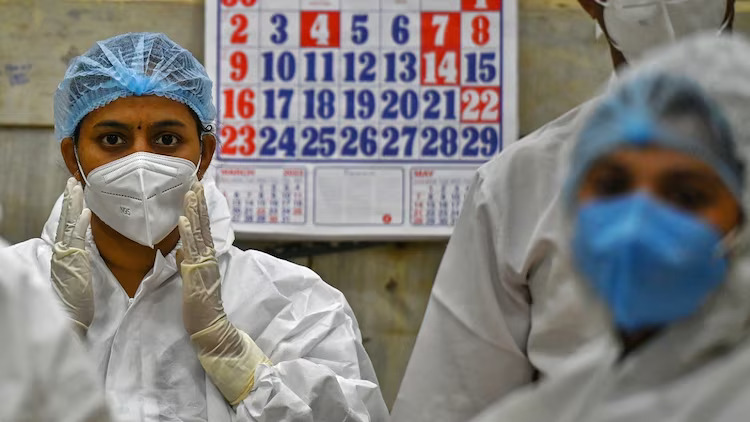In the winter of 2019, the world was preparing to welcome the New Year in the usual festive manner. However, the last few weeks brought about a significant upheaval in everyone’s lives with the arrival of a unique virus originating from China.
Fast forward four years, and although the Covid-19 pandemic has subsided, the virus still persists in various forms within our lives. This December, a new strain of the coronavirus, known as JN.1, is causing a stir worldwide. The World Health Organisation has classified JN.1 as a “variant of interest,” acknowledging that it poses a minimal risk to public health.
In December of 2020, Covid-19 witnessed three significant mutations: Alpha (B.1.1.7), Beta (B.1.351), and Gamma (P.1). Just a year later, in December 2021, the emergence of the Omicron variant forced the world back into lockdown, shortly after restrictions had begun to ease.

Moving on to December 2022, although no major new variant emerged, we witnessed the rise of subvariants such as BA.2 and BA.5, all falling under the Omicron branch of the coronavirus.
And now, we have the JN.1 variant, which also belongs to the Omicron lineage.
A recurring pattern in these variant developments is the month of December, a cold winter month that initially introduced the novel coronavirus to the world in 2019 and early 2020.
To understand why it always seems to be December, we must first delve into the analysis of the new variant, JN.1. This particular mutation of the coronavirus has garnered attention from the World Health Organisation (WHO) as a ‘variant of interest’ due to its rapid spread worldwide. It has already been detected in various countries, including India, China, the United Kingdom, and the United States.
WHAT IS JN.1?
JN.1 belongs to the BA.2.86 lineage, which is a descendant of the Omicron or B.1.1.529 variant of SARS-CoV-2. Notably, JN.1 possesses an additional mutation in the spike protein.
According to Dr G C Khilnani, Chairman of the PSRI Institute of Pulmonary, Critical Care and Sleep Medicine, this new variant primarily causes mild symptoms such as fever, sore throat, cough, and headache. However, it can pose a greater risk to vulnerable populations, including the elderly, obese individuals, and those with underlying conditions like COPD, diabetes, and cancer.

SO, WHY DECEMBER?
Numerous studies have highlighted the impact of cold and dry winter conditions on the surge of Covid-19 cases, as evidenced by the aforementioned mutations. A study published in the journal Nature, which focused on the onset of the second wave triggered by the Delta variant, revealed that weather conditions played a role in the virus’s transmission during the first wave of the pandemic.
As the transition from summer to winter occurred, temperatures dropped, and the air became drier, creating favorable conditions for a more severe second wave of Covid-19 in countries located in the Northern Hemisphere.
Researchers from China’s Sichuan International Studies University also supported a similar hypothesis. Their study found that individuals living in colder environments had a higher likelihood of contracting the coronavirus compared to those in controlled, warmer conditions.
Covid-19, similar to other respiratory viruses, follows a seasonal pattern. There are two factors that are constantly changing: the virus itself and our bodies. As the virus undergoes evolution, new strains emerge, while our immunity to previous strains weakens. This means that there is always a new variant that our bodies are not familiar with, leading to the possibility of recurring infections, as explained by Dr Dipu TS, Associate Professor in the Division of Infectious Diseases at Kochi’s Amrita Hospital, to IndiaToday.in.
THE HOLIDAY TRAVEL
During the holiday season, Covid-19 had the opportunity to spread globally. In December, when the virus first emerged in China, it coincided with the holiday season in both the Northern and Southern Hemispheres. While countries in the South were celebrating Christmas, countries in the Northern Hemisphere, particularly China, were observing the lunar new year in January. This event played a role in the virus’s transmission to other parts of the world. Even this year, the JN.1 variant is spreading rapidly due to the holiday season. Dr Dipu added that the holiday season, with its increased social gatherings, leads to closer contact between travelers and locals, which accelerates transmission.
As international travel gradually returns to pre-pandemic levels by 2023, it will contribute to the spread of the virus. However, experts emphasize that travel should be viewed as a contributing factor rather than the primary cause of the current surge.
Despite the situation, experts advise against panicking and instead recommend exercising caution due to the ever-changing nature of human behavior. Dr Devashish Desai, Consultant in Infectious Diseases at Ruby Hall Clinic, stated that there is currently no evidence suggesting a high prevalence of severe disease manifestations such as hypoxia. However, individuals with underlying health conditions, the elderly, the obese, and those who are unvaccinated should exercise increased caution as the number of cases related to the JN.1 variant rises.
Vaccination and the use of masks continue to be powerful measures against viral infections. The World Health Organization (WHO) has emphasized the importance of these preventive measures in the current situation.

